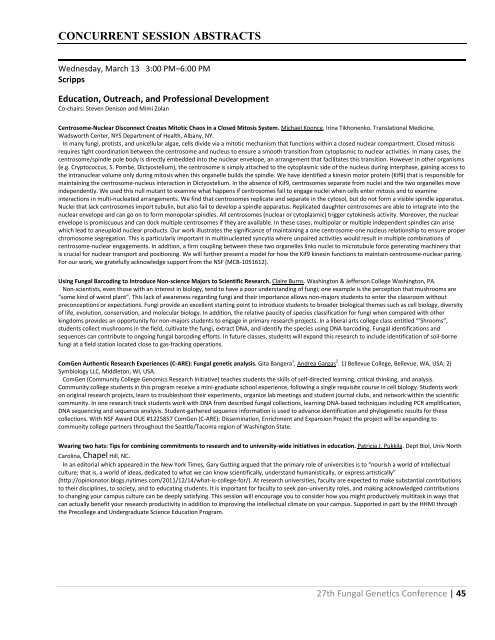Program Book - 27th Fungal Genetics Conference
Program Book - 27th Fungal Genetics Conference
Program Book - 27th Fungal Genetics Conference
You also want an ePaper? Increase the reach of your titles
YUMPU automatically turns print PDFs into web optimized ePapers that Google loves.
CONCURRENT SESSION ABSTRACTSWednesday, March 13 3:00 PM–6:00 PMScrippsEducation, Outreach, and Professional DevelopmentCo-chairs: Steven Denison and Mimi ZolanCentrosome-Nuclear Disconnect Creates Mitotic Chaos in a Closed Mitosis System. Michael Koonce, Irina Tikhonenko. Translational Medicine,Wadsworth Center, NYS Department of Health, Albany, NY.In many fungi, protists, and unicellular algae, cells divide via a mitotic mechanism that functions within a closed nuclear compartment. Closed mitosisrequires tight coordination between the centrosome and nucleus to ensure a smooth transition from cytoplasmic to nuclear activities. In many cases, thecentrosome/spindle pole body is directly embedded into the nuclear envelope, an arrangement that facilitates this transition. However in other organisms(e.g. Cryptococcus, S. Pombe, Dictyostelium), the centrosome is simply attached to the cytoplasmic side of the nucleus during interphase, gaining access tothe intranuclear volume only during mitosis when this organelle builds the spindle. We have identified a kinesin motor protein (Kif9) that is responsible formaintaining the centrosome-nucleus interaction in Dictyostelium. In the absence of Kif9, centrosomes separate from nuclei and the two organelles moveindependently. We used this null mutant to examine what happens if centrosomes fail to engage nuclei when cells enter mitosis and to examineinteractions in multi-nucleated arrangements. We find that centrosomes replicate and separate in the cytosol, but do not form a visible spindle apparatus.Nuclei that lack centrosomes import tubulin, but also fail to develop a spindle apparatus. Replicated daughter centrosomes are able to integrate into thenuclear envelope and can go on to form monopolar spindles. All centrosomes (nuclear or cytoplasmic) trigger cytokinesis activity. Moreover, the nuclearenvelope is promiscuous and can dock multiple centrosomes if they are available. In these cases, multipolar or multiple independent spindles can arisewhich lead to aneuploid nuclear products. Our work illustrates the significance of maintaining a one centrosome-one nucleus relationship to ensure properchromosome segregation. This is particularly important in multinucleated syncytia where unpaired activities would result in multiple combinations ofcentrosome-nuclear engagements. In addition, a firm coupling between these two organelles links nuclei to microtubule force generating machinery thatis crucial for nuclear transport and positioning. We will further present a model for how the Kif9 kinesin functions to maintain centrosome-nuclear paring.For our work, we gratefully acknowledge support from the NSF (MCB-1051612).Using <strong>Fungal</strong> Barcoding to Introduce Non-science Majors to Scientific Research. Claire Burns. Washington & Jefferson College Washington, PA.Non-scientists, even those with an interest in biology, tend to have a poor understanding of fungi; one example is the perception that mushrooms are“some kind of weird plant”. This lack of awareness regarding fungi and their importance allows non-majors students to enter the classroom withoutpreconceptions or expectations. Fungi provide an excellent starting point to introduce students to broader biological themes such as cell biology, diversityof life, evolution, conservation, and molecular biology. In addition, the relative paucity of species classification for fungi when compared with otherkingdoms provides an opportunity for non-majors students to engage in primary research projects. In a liberal arts college class entitled “’Shrooms”,students collect mushrooms in the field, cultivate the fungi, extract DNA, and identify the species using DNA barcoding. <strong>Fungal</strong> identifications andsequences can contribute to ongoing fungal barcoding efforts. In future classes, students will expand this research to include identification of soil-bornefungi at a field station located close to gas-fracking operations.ComGen Authentic Research Experiences (C-ARE): <strong>Fungal</strong> genetic analysis. Gita Bangera 1 , Andrea Gargas 2 . 1) Bellevue College, Bellevue, WA, USA; 2)Symbiology LLC, Middleton, WI, USA.ComGen (Community College Genomics Research Initiative) teaches students the skills of self-directed learning, critical thinking, and analysis.Community college students in this program receive a mini-graduate school experience, following a single requisite course in cell biology. Students workon original research projects, learn to troubleshoot their experiments, organize lab meetings and student journal clubs, and network within the scientificcommunity. In one research track students work with DNA from described fungal collections, learning DNA-based techniques including PCR amplification,DNA sequencing and sequence analysis. Student-gathered sequence information is used to advance identification and phylogenetic results for thesecollections. With NSF Award DUE #1225857 ComGen (C-ARE): Dissemination, Enrichment and Expansion Project the project will be expanding tocommunity college partners throughout the Seattle/Tacoma region of Washington State.Wearing two hats: Tips for combining commitments to research and to university-wide initiatives in education. Patricia J. Pukkila. Dept Biol, Univ NorthCarolina, Chapel Hill, NC.In an editorial which appeared in the New York Times, Gary Gutting argued that the primary role of universities is to “nourish a world of intellectualculture; that is, a world of ideas, dedicated to what we can know scientifically, understand humanistically, or express artistically”(http://opinionator.blogs.nytimes.com/2011/12/14/what-is-college-for/). At research universities, faculty are expected to make substantial contributionsto their disciplines, to society, and to educating students. It is important for faculty to seek pan-university roles, and making acknowledged contributionsto changing your campus culture can be deeply satisfying. This session will encourage you to consider how you might productively multitask in ways thatcan actually benefit your research productivity in addition to improving the intellectual climate on your campus. Supported in part by the HHMI throughthe Precollege and Undergraduate Science Education <strong>Program</strong>.<strong>27th</strong> <strong>Fungal</strong> <strong>Genetics</strong> <strong>Conference</strong> | 45











